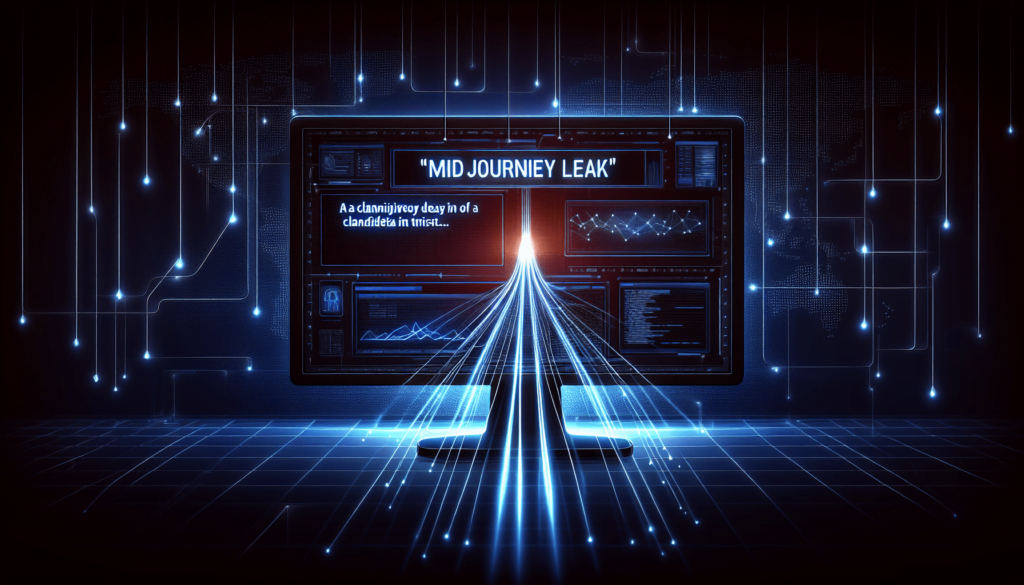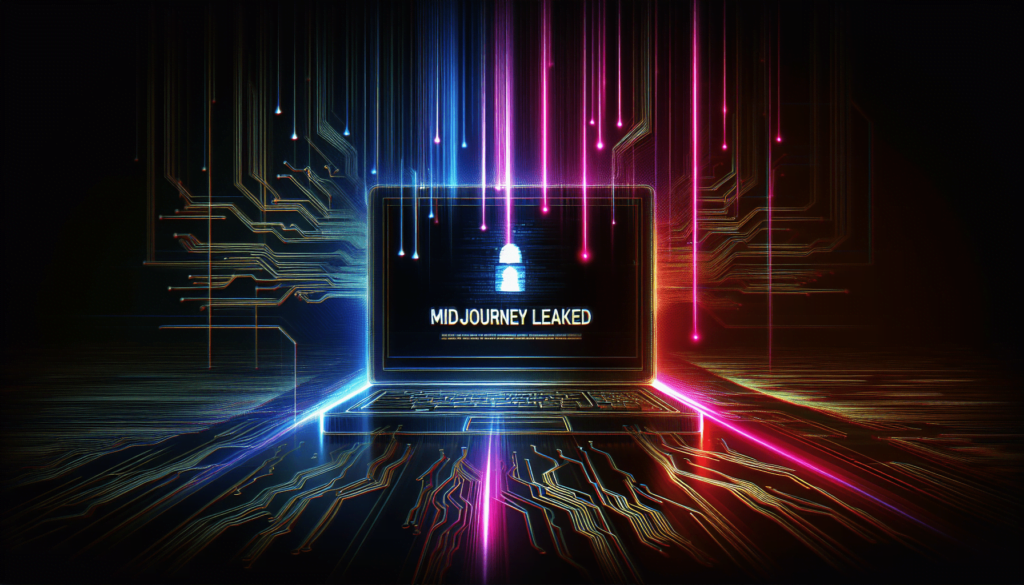In a surprising turn of events, a leaked file has unveiled the extensive list of artists whose works MidJourney has allegedly utilized to train its AI models. The document, shared widely across social media platforms, includes eminent names like Yayoi Kusama, Damien Hirst, and Andy Warhol, alongside a six-year-old child’s heartfelt drawing. This revelation stems from a broader complaint filed against MidJourney, Stability AI, and DeviantArt, accusing them of copying from over 16,000 artists. The controversy has ignited discussions about copyright protections and the ethical implications of using human creativity to fuel AI capabilities. Have you ever wondered how AI art generators create those stunning, lifelike images?

MidJourney Leaked: An In-Depth Look
In the world of AI, there’s always an air of mystique surrounding the technology that powers these sophisticated systems. Recently, a major leak has shed light on the inner workings of one of the most popular AI art generators, MidJourney. A Google Sheet revealed on social media platforms X (formerly known as Twitter) and Bluesky contained an extensive list of thousands of artists whose work has allegedly been used to train MidJourney’s AI models.
What Was Leaked?
The leak encompassed a comprehensive file listing thousands of artists, time periods, styles, genres, and techniques. This list has exposed the underlying dataset used to train MidJourney’s AI, featuring prominent names like Yayoi Kusama, Damien Hirst, Andy Warhol, and Banksy. Astonishingly, it even includes artwork from a six-year-old child named Hyan Tran, whose drawing for the Seattle Children’s Hospital made it onto the list.
The Allegations Against MidJourney
The controversy surrounding MidJourney intensified when it became apparent that works spanning various art forms had been mined without explicit consent from the creators. Not limited to traditional artists, the AI’s dataset also comprises intellectual property from card games like “Magic: The Gathering” and video games developed by Riot Games. Originating from a complaint filed a year ago, this incident highlights the ongoing debate about AI ethics and copyright infringement.
Landmark Decision by the US Copyright Review Board
Adding fuel to the fire, the US Copyright Review Board ruled in September 2023 that images generated via AI platforms could not be protected by copyright law due to the means of their production. This decision has significant implications, essentially determining that artworks produced by AI cannot be legally owned in the traditional sense. For artists and developers, it’s a decision that raises both ethical and legal questions.
The Impact on Artists
The heart of this issue lies in the alleged unauthorized use of countless artists’ works. Let’s break it down for a clearer understanding.
The List of Affected Artists
The magnitude of the leak is vast. Here’s a condensed table illustrating some of the well-known artists whose works were allegedly used to train MidJourney:
| Artist | Notable Works | Style/Genre |
|---|---|---|
| Yayoi Kusama | Infinity Mirror Rooms | Contemporary, Installation |
| Damien Hirst | The Physical Impossibility of Death | Modern Art, Installation |
| Andy Warhol | Marilyn Diptych | Pop Art |
| Banksy | Girl with Balloon | Street Art |
| Francis Bacon | Three Studies for Figures at the Base of a Crucifixion | Expressionism |
Emotional and Economic Toll
Imagine discovering that your life’s work has been used without your consent. The emotional toll this can take on an artist is substantial. There’s a violation of trust and a feeling of exploitation, especially if your distinct style has been absorbed into an AI model that spits out similar works at lightning speed.
Economically, this misuse can deprive artists of potential earnings. If AI-generated images can mimic human-created art, it might reduce demand for original creations, impacting artists’ livelihoods.
Community Backlash and Support
Communities both online and offline have rallied in support of these artists. Artists and advocates have taken to social media, spreading awareness and calling for more robust protections for creative works. Legal actions are being discussed, and some have already been initiated to seek justice and ensure such breaches are prevented in the future.
MidJourney’s Response
Following the leak, what has been MidJourney’s response to these allegations?
Official Statements
MidJourney’s developers have issued several public statements. They acknowledged the presence of certain artists’ works in their dataset but emphasized that their AI’s goal is to generate unique, transformative works rather than direct replicas. They promised to review their data acquisition practices and make necessary amendments.
Measures Taken
To address these concerns, MidJourney has begun implementing preventive measures. They announced plans to refine their algorithms to avoid closely mimicking existing art styles. Improved transparency in data sourcing processes and the introduction of opt-out features for artists are some of the steps being considered.
Ongoing Investigations
Various investigations are underway to examine the depth of this issue. Legal teams are scrutinizing the extent of the alleged copyright violations, while tech experts are assessing how MidJourney’s AI can be recalibrated to respect intellectual property rights.
Ethical Concerns in AI Art
This incident has sparked broader discussions on the ethics surrounding AI in art creation.
Consent and Acknowledgment
At the core of these ethical dilemmas is the issue of consent. Using an artist’s work to train an AI without permission is both ethically and legally questionable. It underscores the necessity for robust frameworks to ensure that artists are informed and can choose whether to partake in such processes.
The Role of AI in Creativity
This controversy also raises philosophical questions: Where do we draw the line between human creativity and machine-generated art? AI can churn out incredibly lifelike images, but is this creativity or replication? Can AI truly innovate, or does it merely combine existing patterns in novel ways?
Future of AI Regulation
The need for regulation in AI use is more apparent than ever. Policies that protect intellectual property while fostering innovation must be developed. Industry stakeholders, policymakers, and artists need to collaborate to create a balanced approach that respects all parties involved.

The Public’s Reaction
Public opinion on this leak and its ramifications is divided. Let’s explore the different perspectives.
Support for Artists
A significant portion of the public stands firmly with the affected artists. They argue that art is a deeply personal and invaluable form of expression that deserves protection. Many believe that unauthorized use of an artist’s work for training an AI undermines creativity and disrespects the artist’s effort and vision.
Emphasis on AI Progress
On the other hand, some tech enthusiasts point to the benefits of AI in pushing the boundaries of what’s possible in art and design. They argue that as long as there are clear guidelines and compensations, using existing artworks to train AI can lead to new forms of creative expression.
A Call for Middle Ground
Ultimately, there’s a growing call for a balanced approach. Many believe that collaboration between AI developers and artists could lead to mutually beneficial outcomes, where AI tools can assist artists without replacing or exploiting them.
What’s Next for MidJourney?
Amidst this controversy, what does the future hold for MidJourney?
Potential Tech Revisions
MidJourney is likely to undergo significant technological revisions. Enhanced filtering systems might be developed to detect and avoid close replication of existing artworks. The AI models may also be trained with stricter ethical guidelines and more diversified datasets.
Legal Repercussions
Legal battles are expected to unfold as affected artists seek compensation and corrective measures. These cases might set new precedents for how AI and intellectual property laws interact.
Evolution of AI Art Platforms
This incident could serve as a catalyst for the evolution of AI art platforms. Increased transparency, improved artist-AI collaboration, and refined ethical practices might emerge as industry standards. AI developers may develop new ways to obtain data legitimately, ensuring artists are respected and compensated.
Conclusion
The MidJourney leak has opened a Pandora’s box of ethical, legal, and emotional issues. It’s a stark reminder of the complexities involved in marrying technology with creative arts. While the technology itself holds immense potential, its ethical use remains paramount, ensuring that the backbone of creativity—the human artist—is not overshadowed or devalued. Whether you’re an artist, a tech enthusiast, or simply a lover of art, these developments mark a pivotal moment in understanding and shaping the future of AI in creativity.
Navigating these waters won’t be easy, but with conversation, collaboration, and conscientiousness, a balanced path forward can be found. So, next time you see a breathtaking AI-generated image, you’ll know a bit more about the unseen hands that contributed to its creation.

